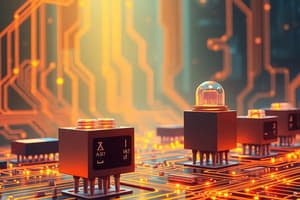Podcast
Questions and Answers
What is the primary function of the base electrode in a transistor?
What is the primary function of the base electrode in a transistor?
- Collects charges from the emitter
- Determines the DC supply voltage
- Controls the flow of charges (correct)
- Supplies free charges
What type of transistor is formed when an N-type base is used?
What type of transistor is formed when an N-type base is used?
- PN
- NPN
- PNP (correct)
- NNP
What is the significance of the arrow in the schematic symbol of a transistor?
What is the significance of the arrow in the schematic symbol of a transistor?
- Indicates the direction of hole current (correct)
- Represents the collector electrode
- Represents the emitter electrode
- Indicates the direction of electron current
What is the main difference between PNP and NPN transistors?
What is the main difference between PNP and NPN transistors?
What is the most common type of transistor used in small electronic devices?
What is the most common type of transistor used in small electronic devices?
What type of transistors are NPN and PNP?
What type of transistors are NPN and PNP?
What is the main purpose of a breadboard?
What is the main purpose of a breadboard?
How are the holes in the power rails area of a breadboard connected?
How are the holes in the power rails area of a breadboard connected?
What is the function of the middle groove on a breadboard?
What is the function of the middle groove on a breadboard?
What happens when you connect holes that are electrically connected?
What happens when you connect holes that are electrically connected?
Flashcards are hidden until you start studying




